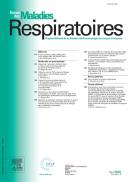Exploring IL13 effects on the remodeling of airway epithelial cell populations by single-cell RNA sequencing - 17/02/23
Résumé |
Introduction |
The airway epithelium is mainly composed of basal cells, mucus-secreting goblet cells and multiciliated cells. The beating of the cilia at the surface of the multiciliated cells allows the clearing of the pathogen-trapping mucus. In asthma, the airway epithelium is subjected to chronic inflammation and impaired regeneration leading to remodeling, decrease in multiciliated cells and goblet cell hyperplasia. Interleukin13 (IL13) secreted by Th2 cells is an important cytokine in the pathogenesis of the disease. The implication of the immune system in this inflammation is well-characterized, however, the epithelium-specific mechanisms of asthma are unclear and whether multiciliated cells can transdifferentiate into goblet cells is still up for debate.
Methods |
To identify cell trajectories giving rise to the asthma-related population imbalance, differentiated human airway epithelial cells were treated with IL13. Epithelial remodeling was observed after eight days of treatment. In order to mimic recovery, we then subjected the cells to a washout period of two weeks. To identify recovery trajectories and elusive cell type intermediates, we performed single-cell RNA sequencing after IL13 and after the washout period.
Results |
Single-cell RNA-sequencing confirmed that IL13 treatment leads to a dramatic epithelial remodeling acquiring an asthma-like phenotype with a shift from a multiciliated to a secretory epithelium. The washout-period resulted in a restoration of the initial cell composition. Cell type-specific IL13 target genes were identified with for instance SERPINB10 expressed in multiciliated cells, or PIGR expressed in secretory cells including goblet cells. Differential analysis revealed a reduction in the proportion of MCC after treatment along with a decrease in their cell identity signature and a strong enrichment in goblet cells carried by an IL13/STAT6 gene signature (CST1, CCL26 or ALOX15). Lastly, MUC5AC-positive multiciliated-cells were observed by immunofluorescence microscopy after IL13 treatment.
Conclusion |
Further analyses are ongoing, in order to identify cellular and molecular events leading to epithelial remodeling and recovery.
Le texte complet de cet article est disponible en PDF.Plan
Vol 40 - N° 2
P. 111-112 - février 2023 Retour au numéroBienvenue sur EM-consulte, la référence des professionnels de santé.


